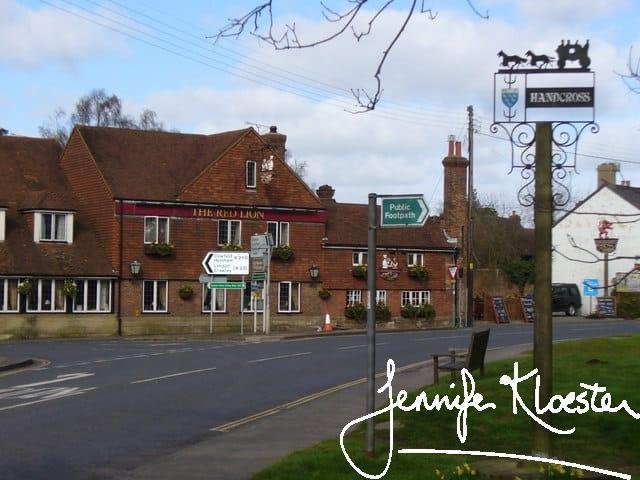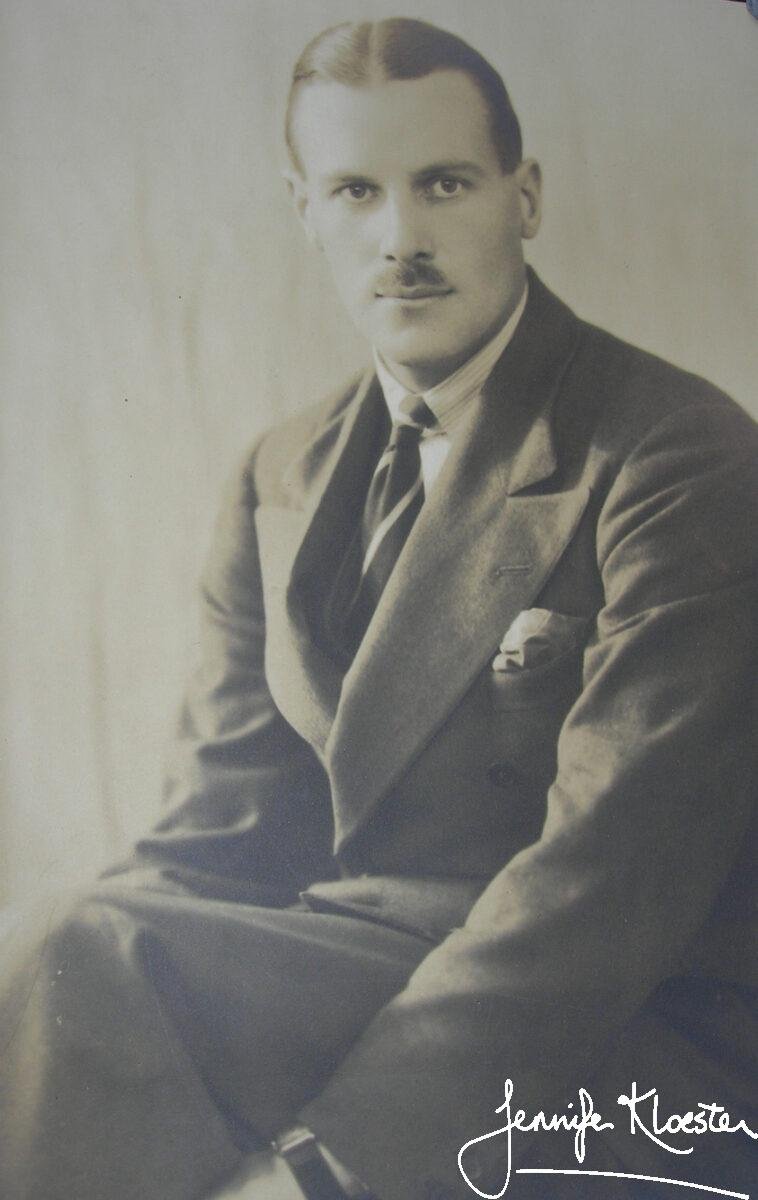
The Talisman Ring and writer’s block
The Talisman Ring had an unusual birth because for once Georgette Heyer had writer’s block – something that would occur only rarely during her fifty-year career. It was April 1936, she was 33, with a four-old son, and she was still the main family breadwinner. With twenty books already under her belt, this was the first time that she’d felt she’d ‘written herself out’. She had struggled for several days over what to write – whether short stories or a novel called Corinthian – and had almost given up, when, as she told her agent’s assistant, Miss Perriam, “a Wholly Glorious novel burst upon me in the space of twenty minutes”. Three hours work gave her the synopsis and a rough outline of the characters and plot and two months later she’d finished writing The Talisman Ring, one her funniest and most delightful novels.

The Talisman Ring set at the Red Lion Inn at Handcross
Georgette set the novel in 1793 in the familiar countryside around Horsham, and much of the story takes place in a country inn – the Red Lion Inn at Hand Cross. She based the fictional inn on the real Red Lion Inn at Handcross on the London to Brighton road, just a few miles to the east of her old home at Southover. The Talisman Ring is one of her ironic comedies and she obviously enjoyed writing it. The novel has a memorable cast of characters including the redoubtable Miss Sarah Thane and her gourmand brother Sir Hugh Thane, the unshakeable Sir Tristram Shield, drama-loving Eustacie de Vauban, reckless young Ludovic Lavenham, and the silken-tongued Basil Lavenham. Georgette also made the most of her shrewd innkeeper, Nye, and a pair of Bow Street Runners whose determination to catch a murderer lead to some of the funniest scenes in the book.
Georgette faces changes and challenges
Heyer face a number of changes and challenges through April and May. Her son Richard, aged four, had become ill and needed an operation, and as Georgette explained, “When worried I find it impossible to write light-hearted adventure”. Richard eventually recovered and she was able to get on with her writing, but there was a major change on the horizon which must also have occupied her mind. After much discussion, Ronald had finally decided to “chuck in the sports store” and read for the Bar.

Ronald had done his best
Ronald had done his best to make a go of the sports store and contribute to the family coffers, but it had not proved a fulfilling occupation for a man of his experience and ambition. While there were aspects of country living which he enjoyed, the move to Sussex must have been an adjustment, especially after the adventure of the Caucasus, the wide expanses of Africa and the challenge of Macedonia. By the time his son was born in 1932, Ronald had owned the Russell Hillingdon Sports Store for a year, but on Richard’s birth certificate he gave his occupation as ‘mining engineer’ rather than “retailer” or “shop owner”. Despite her worries over bills and where to find the money to pay for their renovations, in 1936 Georgette and Ronald agreed that he should fulfil his long-held ambition and become a barrister.
An expensive undertaking
In England in the 1930s reading for the Bar was expensive. A candidate could not accept briefs or be paid during his three years of training and the system effectively precluded anyone without a private income from becoming a barrister. There were also the costs of admission fees, lecture fees and term dinners, the hire or purchase of a wig and gown, and the expenses of obtaining and keeping a place in an established chambers. Though different today, in the 1930s Ronald was required to seek admission to one of the four Inns of Court and show that he was not engaged in any profession which disqualified him from being called. This meant that, even if he had wished to continue running the sports store, he would have been compelled to give it up because the tradition in the Courts denied entry to ‘any person engaged in trade’. It was an archaic system and one firmly based on class.

The Inner Temple
It cost over £200 to gain admission to the Inner Temple and another £100 once a candidate was called to the Bar. There were four terms a year and it took a minimum of twelve terms to qualify, during which it was necessary to pass Parts I and II of the Bar Examinations. The exams for Part I could be taken at any time after admission but Part II could only be attempted after the successful completion of a minimum of six terms. The Bar student attended regular lectures run by the Council of Legal Education in London and was also required to ‘keep his terms’ by ‘dining a certain number of nights of each term in the Hall of his Inn’. Although this ancient tradition was now little more than a formality it was still considered a necessity and a student dined in Hall on at least six nights in each term. Ronald applied for admission to the Inner Temple in the spring of 1936 and Georgette wrote to Miss Perriam to say ‘If you can think of any way whereby I can raise ready cash by my pen, pray tell me of it!’.

Woman’s Journal
Only a month before writing The Talisman Ring, Georgette had asked Miss Perriam whether she thought Woman’s Journal would buy a second Regency romance? The magazine was one of Britain’s most successful and a serial sale not only meant a much-needed fee but also increased book sales. Magazine serials always came out a few months before the book’s publication, thereby encouragng readers to order the novel in advance. The serial was meant as a delicious appetiser, designed to entice the reader to buy the book and feast on the unabridged version. The early chapters of The Talisman Ring were clearly enough to convince the Woman’s Journal editor, the formidable MIss Dorothy Sutherland, that the novel would make an excellent serial and by mid-May Georgette had sent through the first instalment.





6 thoughts on “The Talisman Ring – part one”
The Talisman Ring is my favorite story to introduce to those who have never read Georgette Heyer’s delightful books. The outrageous plot twists, fascinating characters and subtle word sketches wrap one in a delicious world of escape. The juxtaposition of two couples at different stages of their lives encountering unimagined adventure entangles the reader’s heart with Heyer’s world. Thank you for sharing these wonderful visual gems of dustcovers that met the standard of a writer of the highest quality! It is like stepping into a past that I never experienced. Pastel is another unique jewel, to be treasured and read over again. Either of these stories might make a fascinating movie to invite new generations!
Hi Leebeth
As you can see, I’m finally connecting with my website again! I’m so pleased you enjoyed this post and I love that you also suggest The Talisman RIng to first-time Heyer readers. I do the same! Thanks for sharing.
Thank you for sharing these rare drawings. What a treasure.
My pleasure, Tammy. So glad you like them.
Thank you for all this wonderful information. I absolutely love The Talisman Ring. Sarah Thane is one of my favorite heroines. It is very interesting to know what was going on in Georgette’s life while writing it. I look forward to part 2
Thanks for writing Lynn. I’m delighted that you’re enjoying the posts and hope you like Part 2 of the Talisman Ring. One of my favourite books and heroines!